New tests in July 2021.
KDP crystals - test report Jan-Mar 2016
In collaboration with the NTE team, it was decided to test KDP/DKDP crystals and their
potential as thermal emission blockers. These crystals, KDP (potassium dihydrogen phosphate) and
its deuterated analog DKDP, are described in e.g. Xu et al. 2012 (PDF file)
, and have the unique property that they can block emission redward of ~ 1.6 micron while
they have a transmission of > 90 % from optical to ~ 1.4 micron. They can therefore serve to block
thermal infrared emission for filters with unwanted red leaks. The NOTCam Z-band filter is such a
filter.
For test purposes it was decided to purchase small KDP crystals from United Crystals, and 3 pieces
arrived as follows:
- KDP, Z-cut, diameter 24.8(+0/-0.2)mm, thickness 4.0(+0/-0.5)mm, polishing only, no coating
- KDP, Z-cut, diameter 23.8(+0/-0.2)mm, thickness 4.0(+0/-0.5)mm, polishing only, no coating
- DKDP, Z-cut, diameter 23.8(+0/-0.2)mm, thickness 4.0(+0/-0.5)mm, polishing only, no coating
One of the practical challenges with these crystals is that they have a low tolerance to humidity.
Their properties deteriorate with exposure to water vapor.
Wheeler et al. 1999 (PDF file)
studied the severity of exposure to environmental effects such as water vapor, and conclude that
water is absorbed into the porous coating and etches into the surface of the KDP. From their graphs
we estimated that 3-4 hours of exposure to 55-75% RH would be ok.
Mounting test units in the aperture wheel of NOTCam
On the 15th of January two of the crystals were installed in two small slots of the aperture wheel of NOTCam.
The vacuum sealed packages were opened in the last minute, and the crystal were exposed to ambient air
(measured to have RH ~ 32%) during about 1 hour before NOTCam was put on the vacuum pump. The crystals
were uniform and transparent.
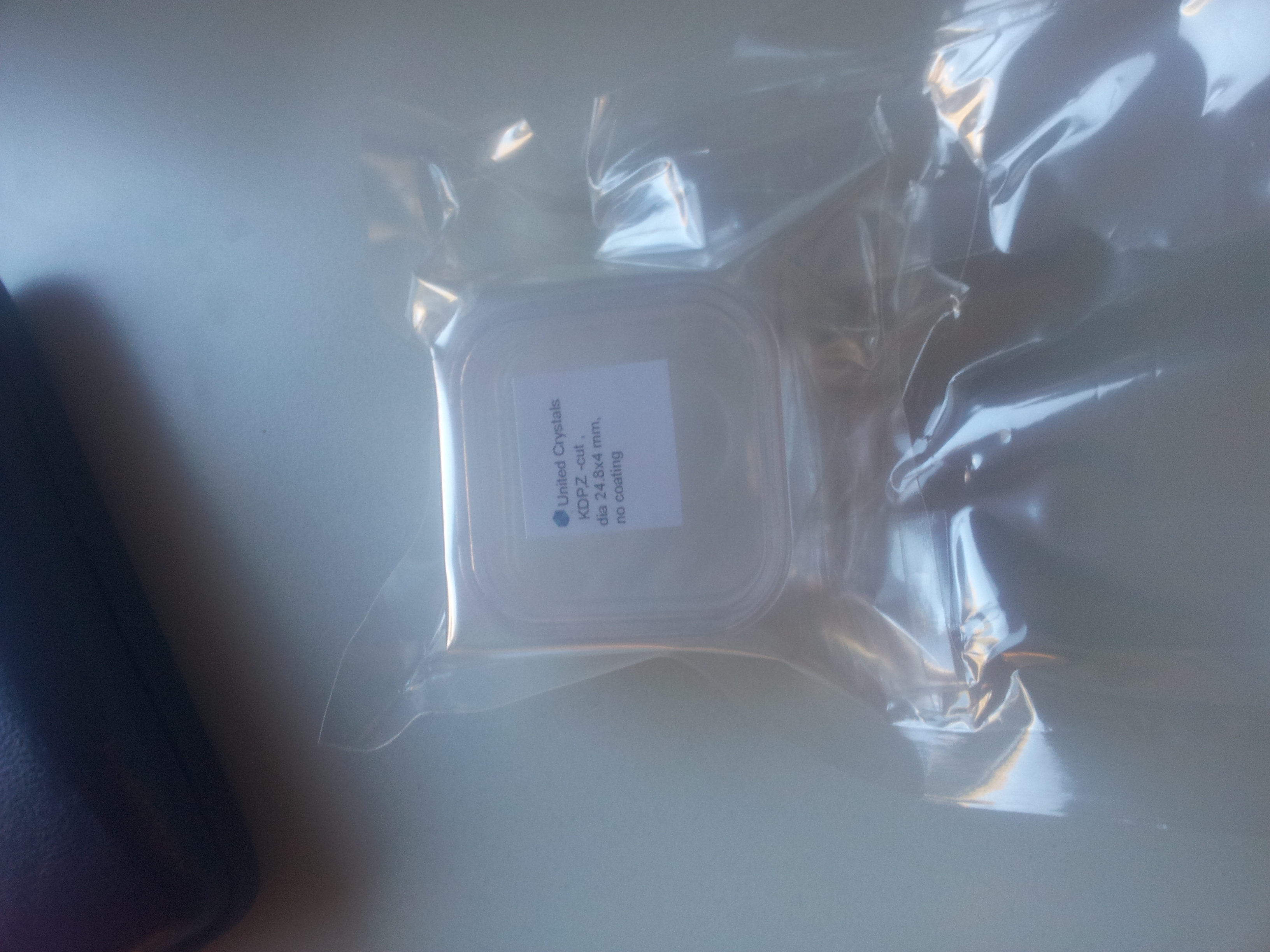
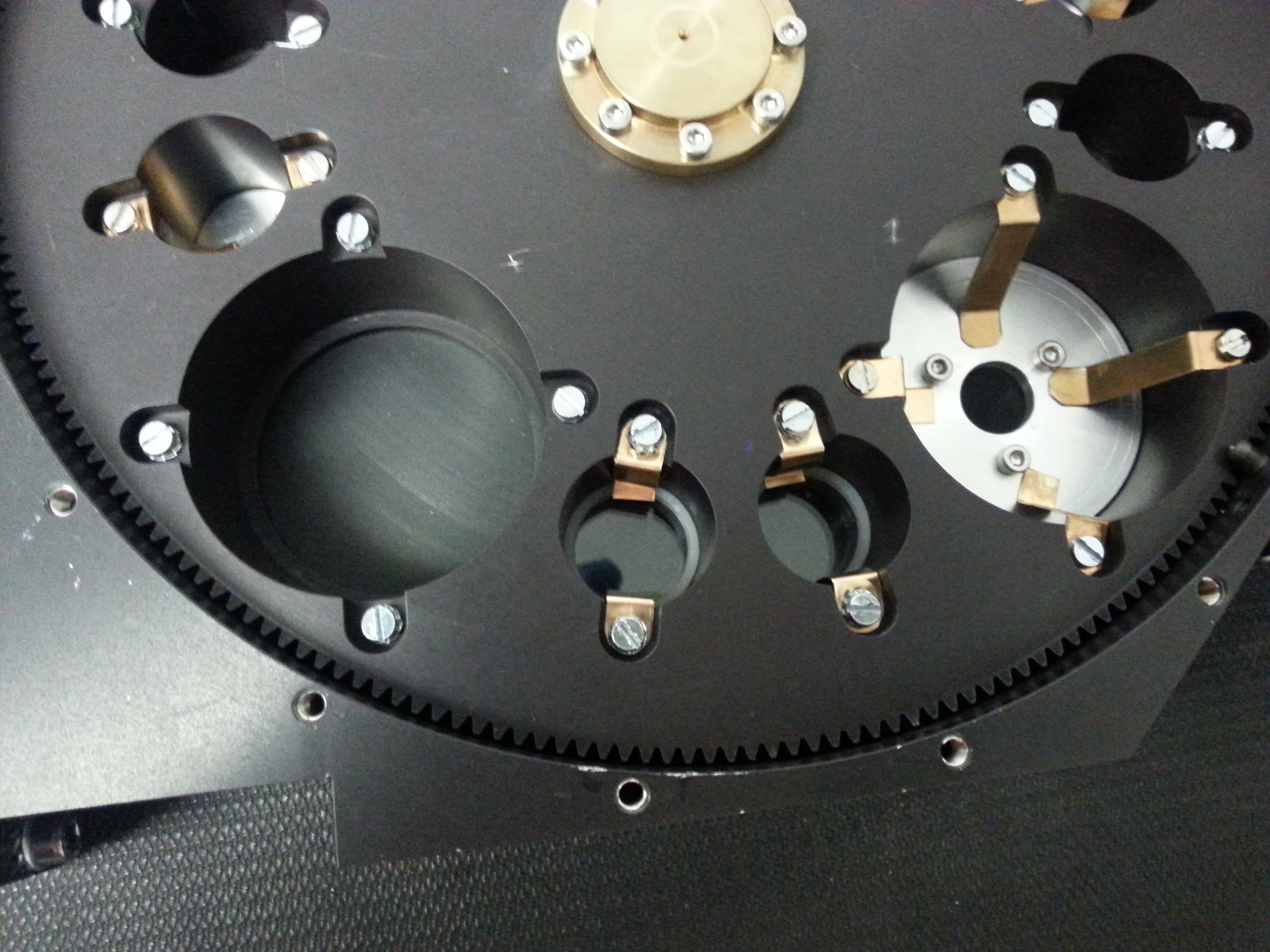
NOTCam was pumped for 5 days, cooled with the PTR for 24 hours, then filled with LN2.
48 hours later NOTCam reached operating temperature and was mounted on January 23rd.
Domeflats ON-OFF were taken to estimate throughput and thermal blocking efficiency.
No tests were made on the sky due to clouds.
Images of domeflats through Y-band and KDP/DKDP
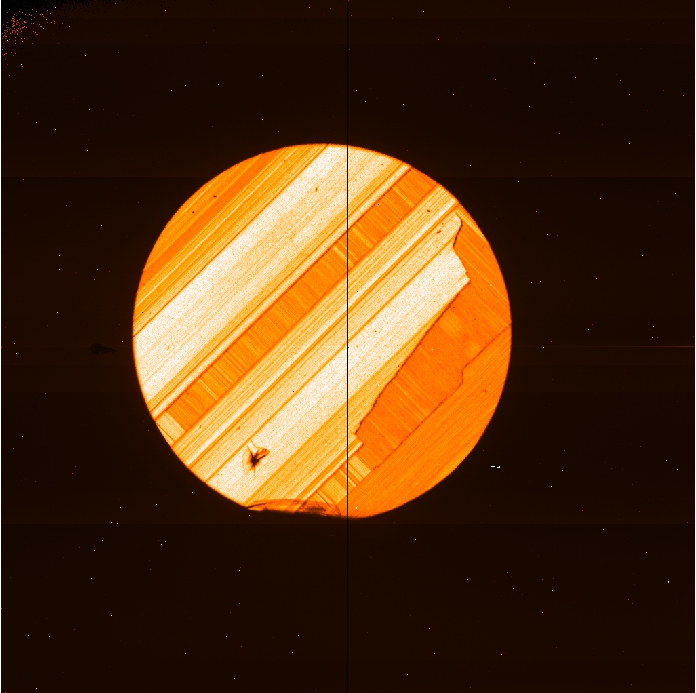
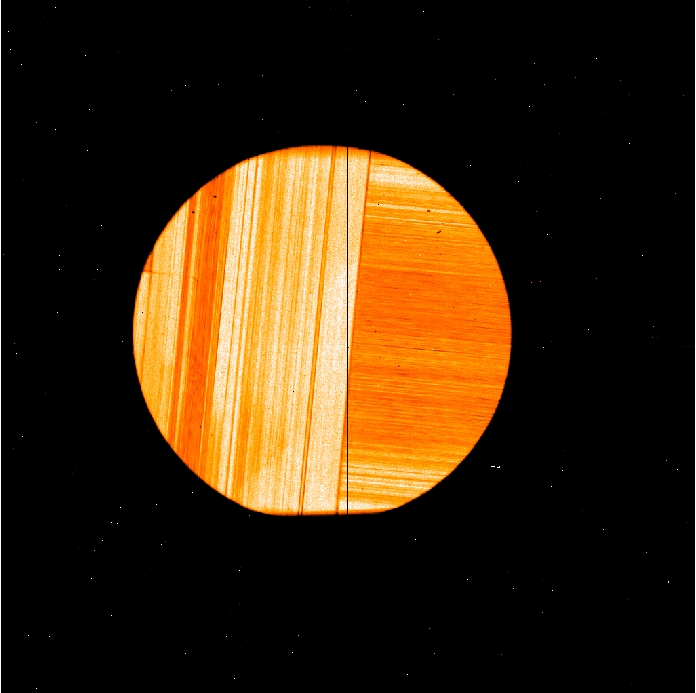
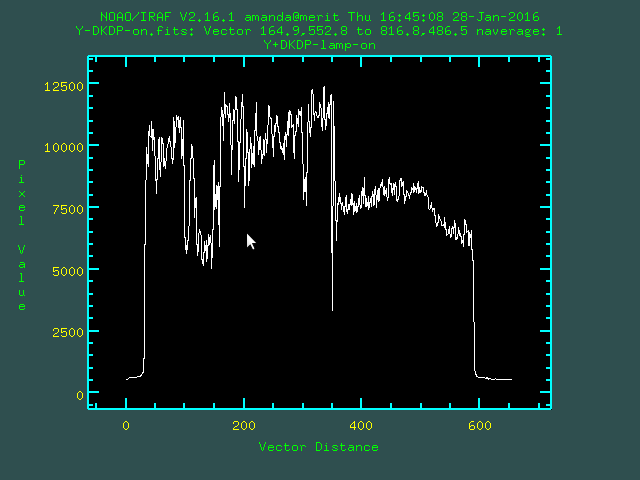
Y-band domeflats with the KDP (left) and the DKDP (middle) in the aperture wheel.
The cross-section (right) is across the DKDP.
There is a profound structure seen in the KDPs and the throughput varies by a factor of
two across their surface. This structure looks the same through all filters tested.
Visual inspection of KDP/DKDP through entrance window
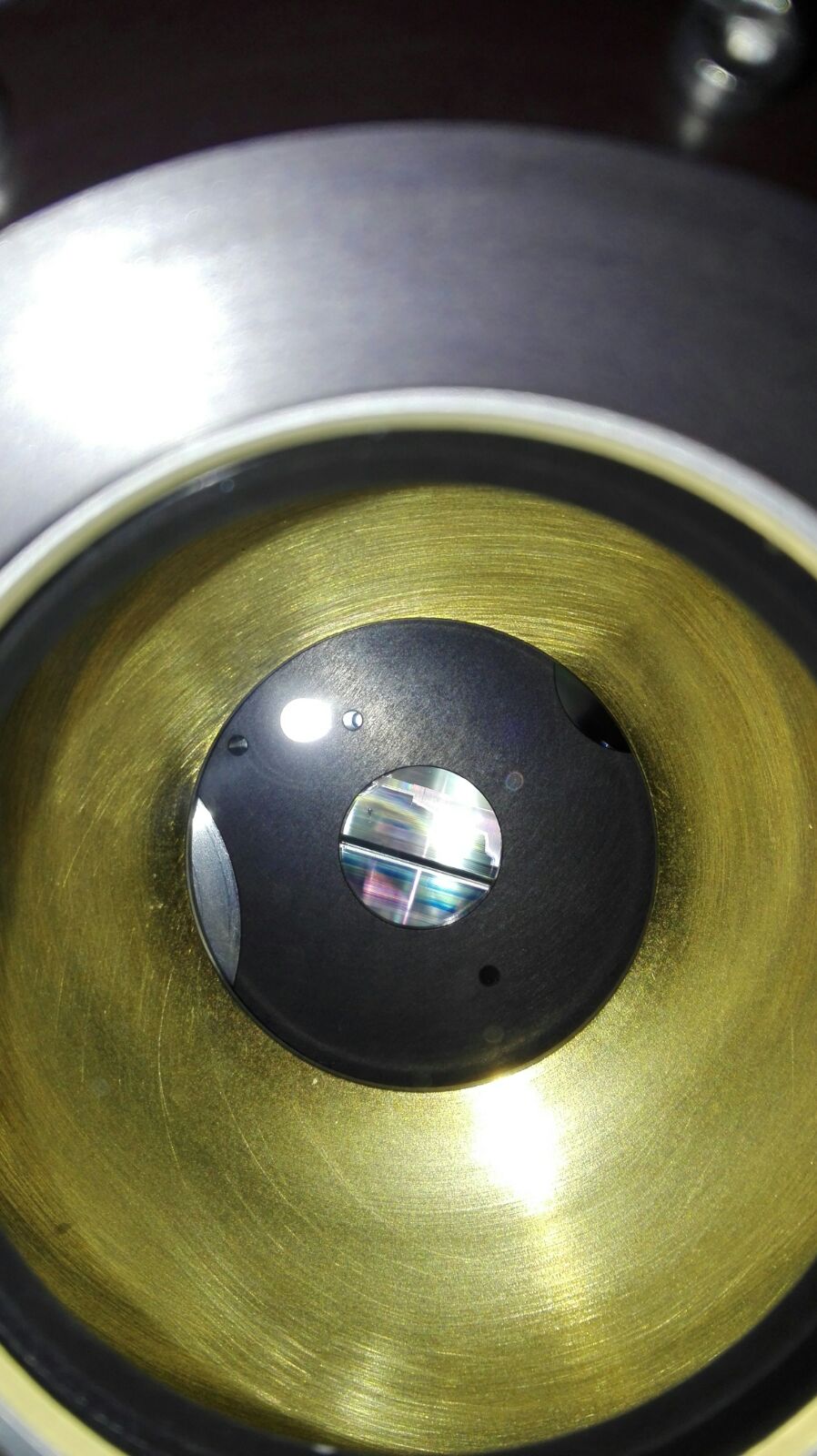
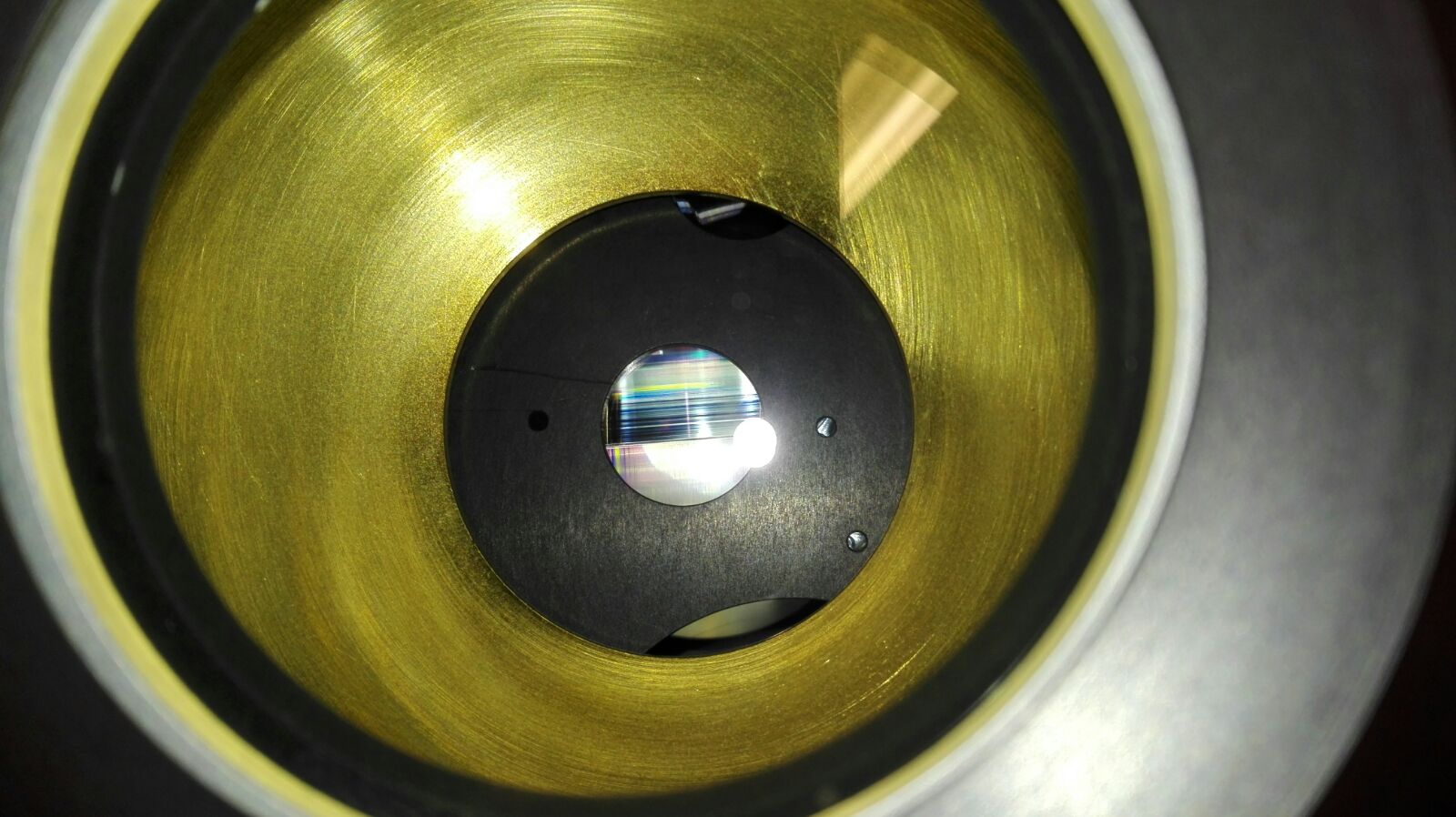
The KDP (left) and the DKDP (right) in the aperture wheel seen through the entrance
window.
The same structure is seen by visual inspection of the crystals (see above photos obtained by Carlos).
This means that their appearance have changed since they were mounted.
At first, it was believed the filters had cracked due to thermal stresses during cooling down.
Approximate KDP/DKDP transmission
Disregarding the structure over the KDPs, where the throughput varies by a factor
of two, the average throughput, measured over the whole surface was estimated at
several wavelengths using ON-OFF domeflats to correct for thermal emission leak (Z).
Average throughput of KDP and DKDP measured from domeflats ON-OFF.
| Unit |
Z
(0.889 µm) |
Y
(1.020 µm) |
HeIA
(1.079 µm) |
Pa gamma
(1.094 µm) |
Jcnt
(1.211 µm) |
J
(1.250 µm) |
Pa beta
(1.287 µm) |
| KDP |
68 % |
70 % |
69 % |
68 % |
64 % |
71 % |
- |
| DKDP |
68 % |
- |
- |
- |
- |
73 % |
- |
KDP/DKDP transmission in Z-band measured on standard star
On Feb 23 2016 we finally got a short test made in clear sky on standard star AS26-0 (FS23, M3-193)
which is a Z_MKO standard used by UKIDSS at Z = 13.500 +- 0.015 mag (UKIDSS DR4). Observations were
made as 5-point dithers on this star, using frame 4 4. The reductions were made skipping the
1st of every 5-image loop (due to reset-anomaly), flat-fielding using the Z-band differential
twilight flat, shifting and combining the 4 individual images into one final image.
Below is shown Z filter only (left), Z+KDP (middle), and Z+DKDP (right) of the ~ 2' central field
of AS26 (N up and E left).

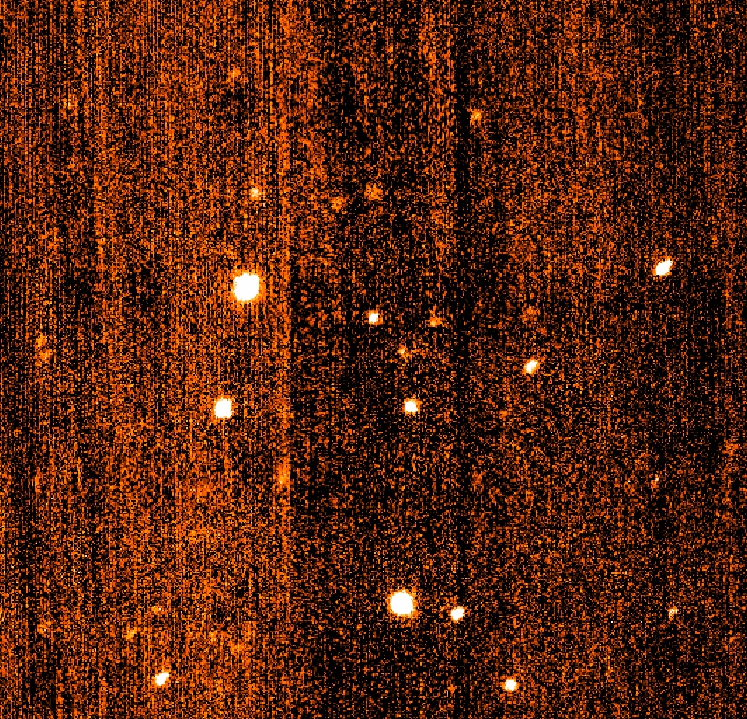

The optical quality is bad, and the PSF is distorted in one or the other direction depending on
the structure of the KDPs just in front. In the combined images this is somewhat smoothed out.
In the background of the two KDP images one sees a remnant of the reset anomaly as a broad vertical
band (brighter or fainter). In addition, the narrower slightly tilted stripes are due to pick-up
noise, often seen in very low-background images.
The throughput measured on the standard star varies strongly over the KDPs, with an average value
of about 70%. This agrees with the estimate found from domeflats. The throughput varies by a factor
of two across the highly structured surface, thus transmission from 50% to 90%. Expected throughput
is 90%.
KDP/DKDP thermal blocking in Z-band measured on standard star
The sky background was measured using the 4/5 dithered images subtracting a dark obtained in the
same mode (i.e. dframe 4 4. While the 16 second integration through the Z-band gives a count
level of 4720 adu, when inserting the KDP/DKDP the sky background reduces to 47/55 adu, a factor of
100. This brings us to a sky background of ~ 18.2 mag/square arc second through the Z-band, which
compares well with the WFCAM/UKIRT background, and shows that both of the KDPs block the thermal
emission efficiently.
Structure disappeared when warming up!
Amazingly, when opening up NOTCam on March 7th to take out what we believed were cracked crystals,
they had regained their original appearance, i.e. no cracks or structure seen, the crystals had
again become completely transparent. To protect the crystals from humidity, they were unmounted
and stored in a dry environment.
Monitoring structure formation during next cool down
When closing NOTCam again, only the KDP was re-mounted for further
testing. NOTCam was pumped from March 8 until March 15 when the PTR was started. During the slow
cooling down of NOTCam we checked the KDP appearance. See photos kindly obtained by Joonas, Tapio,
and Pedro below:
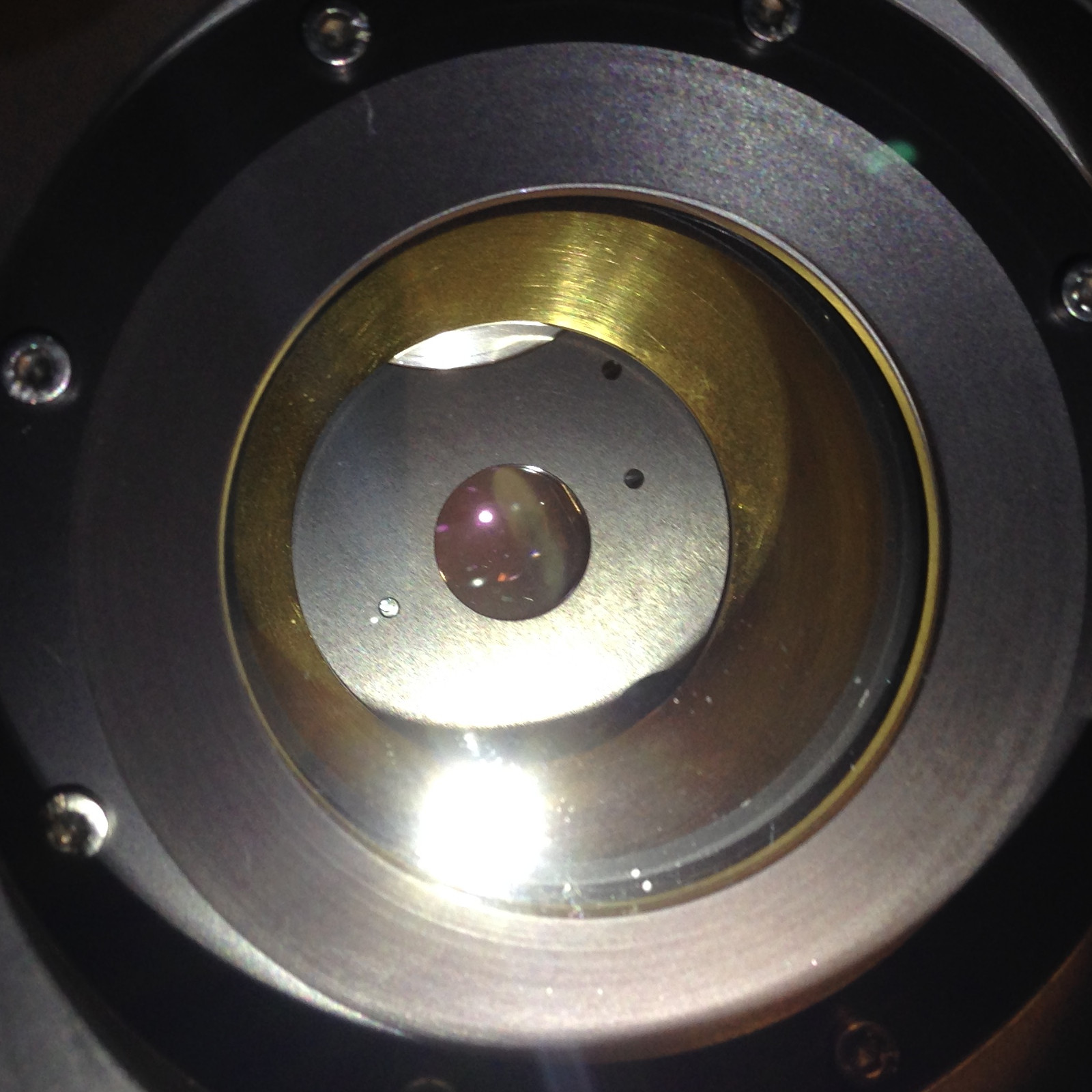
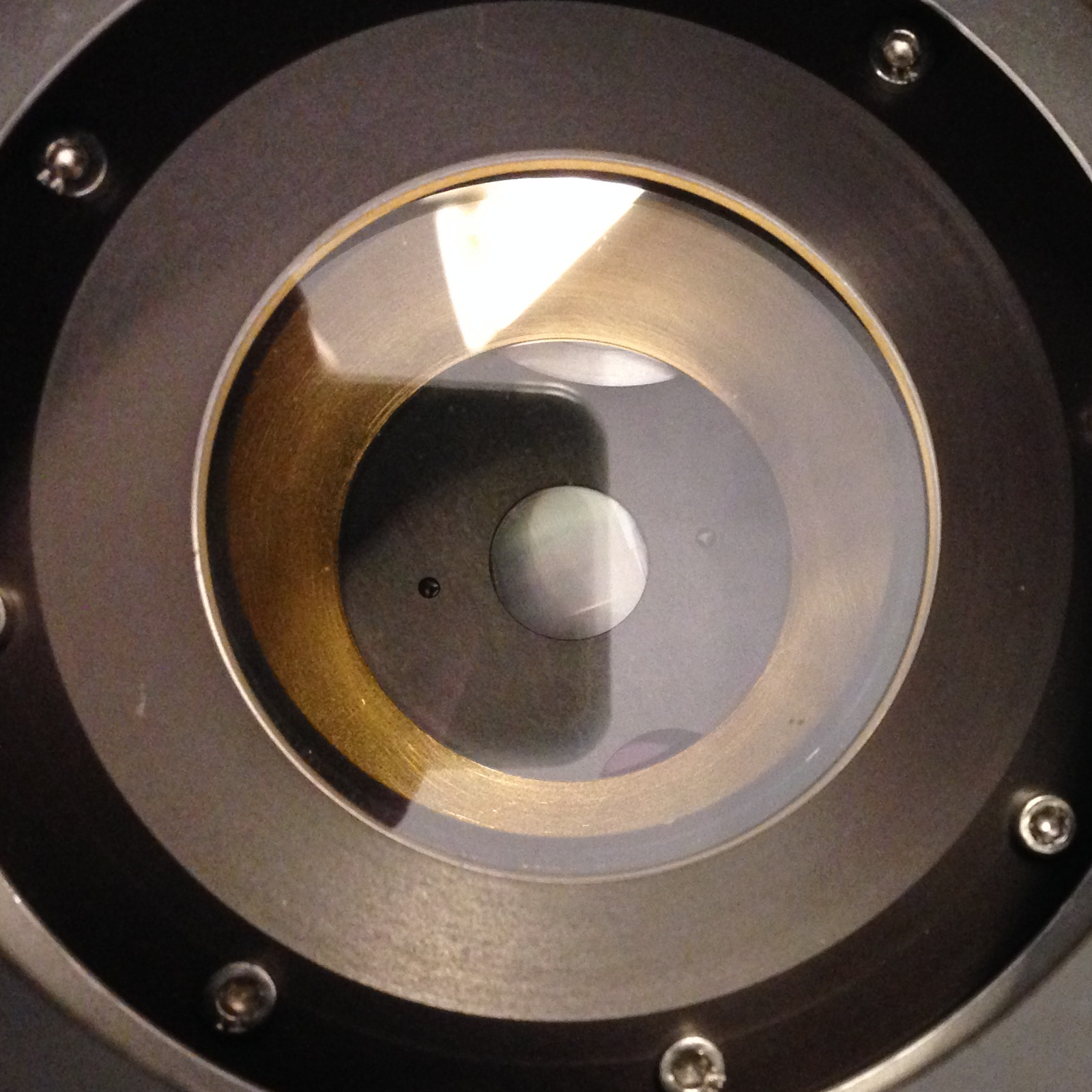

The KDP photographed through the entrance window at different times during the cooling down:
at -73 degrees (left), at -79 degrees (middle), and at -108 (right). These numbers are the
temperatures measured at the center wheel section inside NOTCam. The exact temperature at the
KDP in the aperture wheel is difficult to know.
Conclusions
- The average transmission is lower than the expected 90%, but this is likely due to the
spatially highly structured appearance of the crystal. The transmission varies across the
surface by a factor of two.
- The cause of this structure in the crystals is believed to be due to thermal stresses.
- The optical quality is strongly affected and can not be properly evaluated.
- The thermal blocking efficiency is, however, promising. Confirmed on sky.
- The structure in the crystal disappears when warming the KDPs up again.
- On the latest slow cool-down, the structure seems to come back at a temperature of
around -80 degrees and definitely by -100 deg.
Comments to Amanda
KDP crystals - test report Jul 2021
Installation of KDPs in NOTCam
The two small-sized crystals, designed for the aperture wheel small slots, were brought
from Denmark on July 3rd and installed in NOTCam on July 4th. The conditions in the
clean room were 14 % relative humidity and 30 degrees Celsius. It took less than 3 hours
from opening the KDP boxes until NOTCam was closed and pumping started. This was a bit
longer than expected due to a problem with a broken wire to init switches that needed
understanding and repair. When lowering the pieces into the deep and narrow slots in the
aperture wheel a narrow strip of optical paper was used to "lift" them down. As before a
ceramic ring was put on top and pressed down by two cupper springs.
The KDP is installed in slot 2 in the aperture wheel and the DKDP in slot 9. (Later it
was verified that the pieces had been swapped, so it is actually the opposite.)
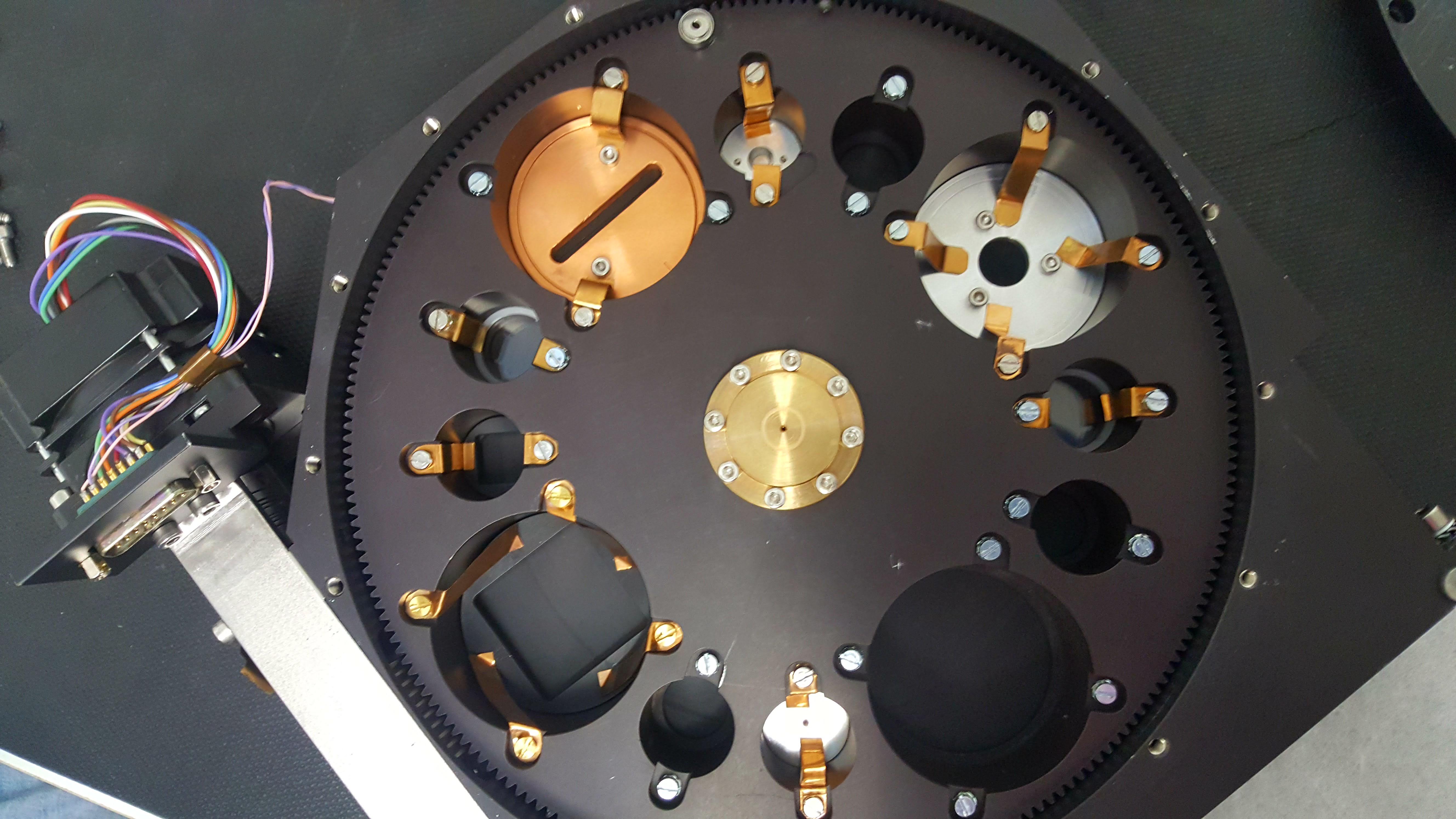
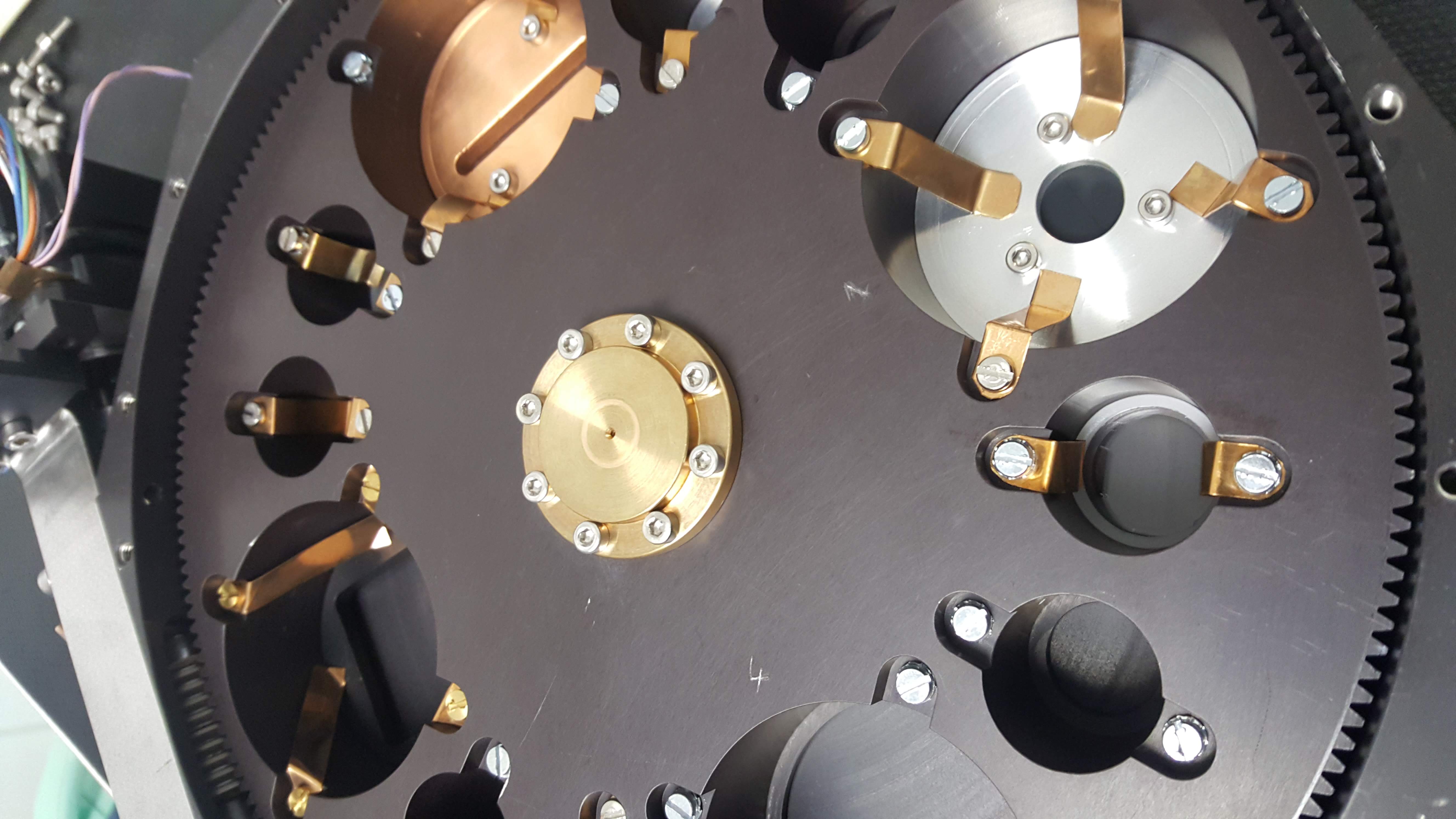

The way the crystals were marked now is interchanged with the way they were before, and
that is easily seen due to the scratch made when mounting them in 2016 on what we then
called KDP (see domeflat figure from 2016), while that same mark is now on the DKDP,
which can be seen from the third photo by zooming in. Observations of the blocking in
the H-band will tell which is which.
Monitoring through entrance window during cool-down
Before starting the PTR cooling the pumping was going on for 5 days starting out with
a temperature of the central wheel section of +40 deg a result of installing the hot
newly baked getter. The KDP crystal in slot 2 was put in the beam and the other was
far away from the beam. The idea was to see if this would affect the structure
formation.
During cooling down with the PTR only and while still pumping, there were some photos
taken with mobile phone cameras through the entrance window, see below. To the left: a
photo taken 12/7 at UT=01:32 when the center section was at -93 deg, in the middle: a
few hours later at UT=04:35 when the temperature at the central wheel was at -98 deg,
and to the right: at UT=09:40 before starting the LN2 filling and at a temperature of
the central wheel section of -106 deg. Clearly a structure of parallel lines across
the KDP can be seen.
Thanks to Paco Galindo, Anni Kasikov, Marcelo Keniger, and Carlos Perez for taking a
good number of photos.


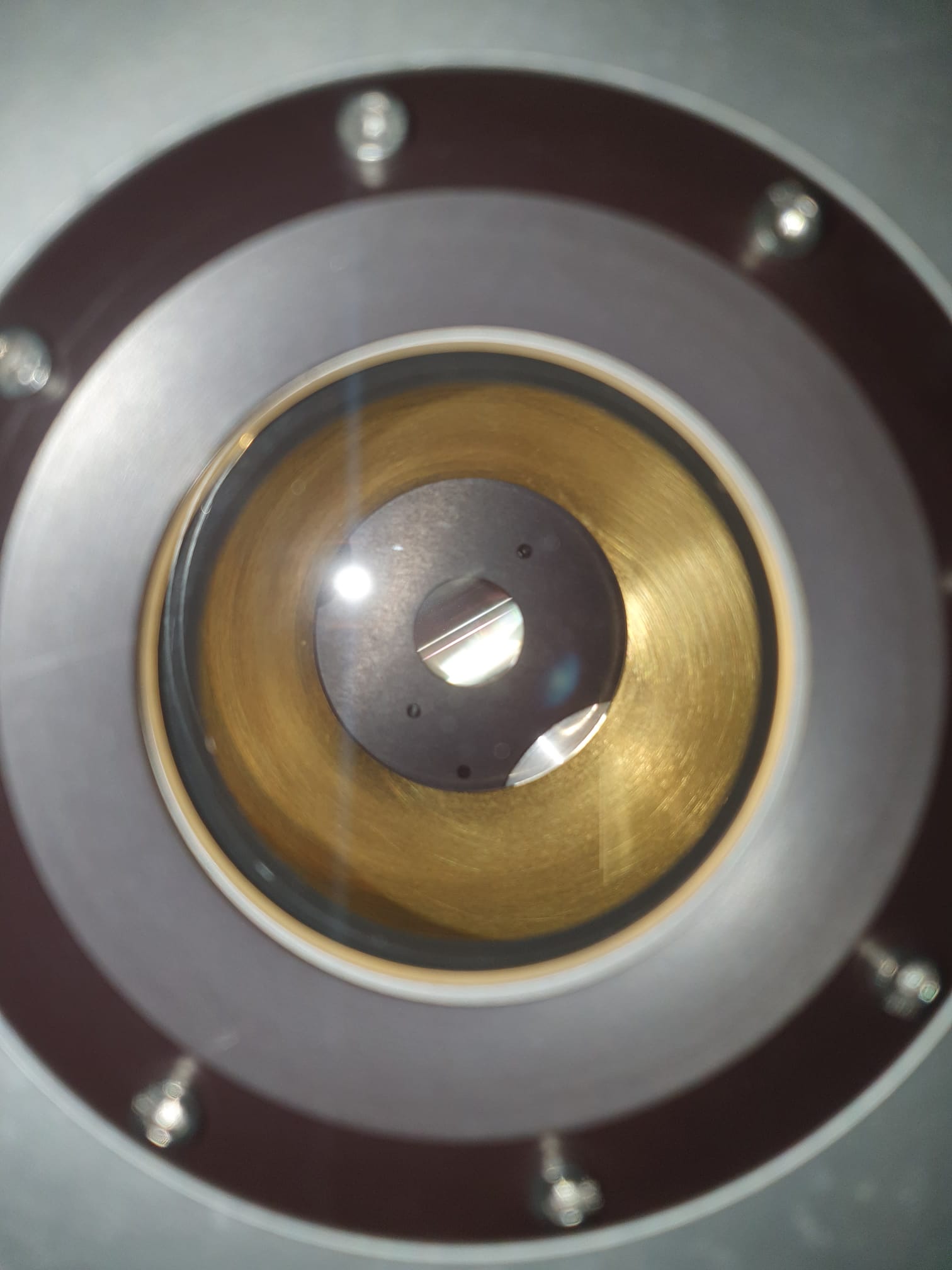
Checking the pieces cold
There was uncertainty about whether the packages had been correctly marked, and the first
thing to check was this. According to Xu et al. 2012 the DKDP has
substantial more throughput in the H-band than the KDP. Domeflats in the H-band without
KDPs and subsequently with, gave a throughtput of about 20000 adu (H only), 10000 adu
(H + KDP) and 3000 adu (H + DKDP), so it was evident the pieces had been swapped and they
were consequently renamed correctly. The piece with a tiny mark is the KDP (it was scratched
the first time we tried mounting it in 2016).
See below a figure of the two pieces as domeflats through the Y-band filter. The structure
in each piece is equally clear, i.e. no evidence of less structure in the piece that was in
slot 9, far away from the beam. Both show strongly variable throughput, but the morphology
of the crystal structure is different from what they showed in 2016 (to the right). You
can see that the scratch mark on the KDP is now at about 9 o'clock while in 2016 it was at
about 7 o'clock.
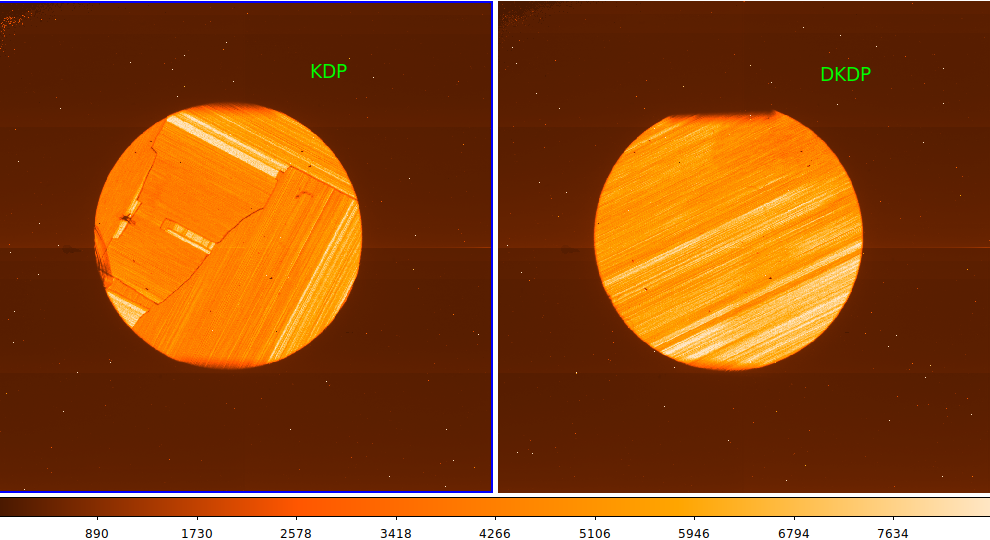


Capacity to block thermal emission
We checked the capacity to block thermal emission with the Z-band
filter and dome lamps ON and OFF. With the exposure mode "frame 4 3" the Z-band gives
11463 adu with the lamp ON and 9598 adu with the lamp OFF at the time of taking the data,
showing the severity of the thermal leak. The true lamp throughput being only 1864 adu
(measured in the central part for comparison with KDPs). The figure below shows the
domeflats taken with the lamp OFF: Z-filter (9598 adu), Z+KDP (45 adu), and Z+DKDP (47 adu),
all dark subtracted with "dframe 4 3" integrations. The blocking capacity on average over
the non-uniform KDPs is thus very good, and the 0.5% that the KDPs let through could be due
to daylight leakage through the dome at these wavelengths.

Another test was made with the K-filter where the KDPs are supposed to block completely.
For scaling to the K-band without KDPs we needed to use an exptime as short as 4 seconds
where the K-band gave 18776 adu. Putting in the KDPs in the beam the figure below shows
K+KDP and K+DKDP dark subtracted. While the KDP blocks completely (to the limit of these
observations), the DKDP lets through an average of 5 adu/pixel, a fraction of 1/3755 or
0.027%.

Transmission of the KDPs (Z band)
By subtracting the lamp OFF images from the lamp ON images, we get both the thermal emission
and the dark removed and are left with the true lamp throughput. Dividing by the Z-image without
KDPs (ON-OFF), we get the fractional transmission of the KDPs in this band. The images below
show the variable transmission across the surfaces: KDP to the left, DKDP to the right. The
highest throughput is around 80%, while the typical throughput is around 40-50%.
The expected throughput is 90%.
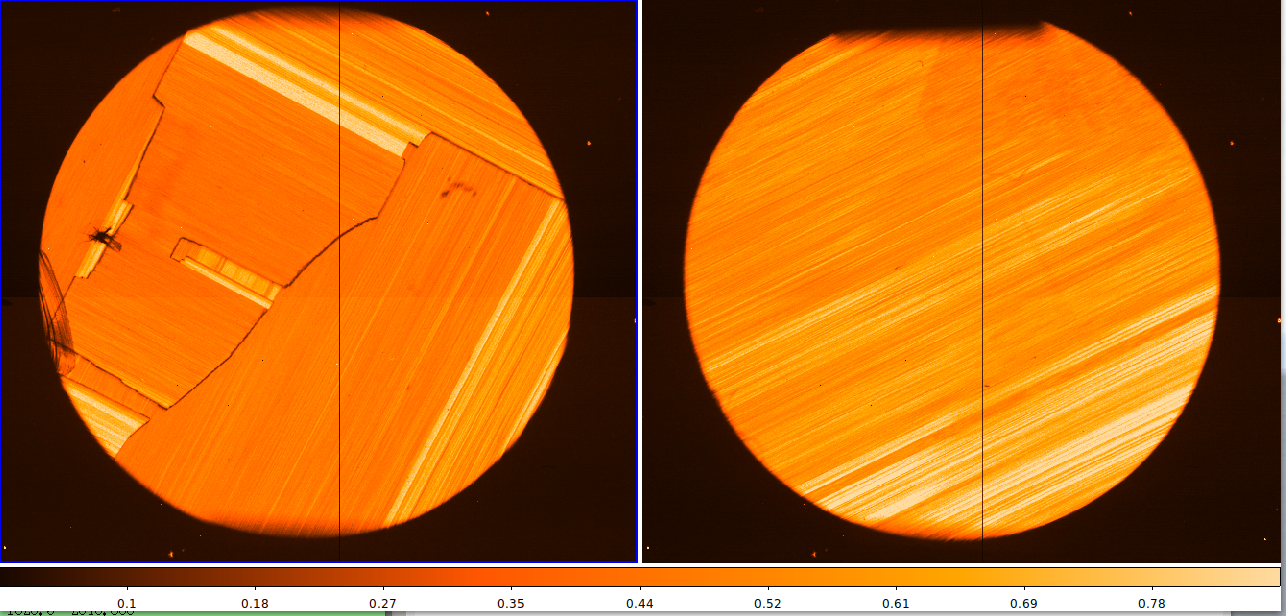
Transmission was measured also through other filters. Analysis TBD.
Measurements on stars (Z-band)
The focus offset to apply for the 4mm thick KDPs in the aperture wheel is around +200 units of
telescope focus. The figure below shows the same stellar field with the Z-band (left) and with
Z + KDP (right). Both are sky-subtracted with a local sky produced by dithered images filtering
out stars, and flat-fielded. The standard deviation in the background of the Z image is around
50 adu while in the image with a KDP added it is only 5 adu.
Due to the lower background noise, fainter sources can be measured, but with NOTCam we are now
limited by the pick-up noise (stripy structure).
The throughput of stars is measured to range from 40 to 85%, quite in agreement with what found
from domeflats. The PSF fwhm is about the same when the focus offset has been applied, but the
seeing was not particularly good when testing so it was not fine-tuned, fwhm ~ 1.10'' in the
Z-image and 1.26'' in the Z+KDP image.
The images below are single exposures of 10.8 seconds obtained with "frame 3.6 3".
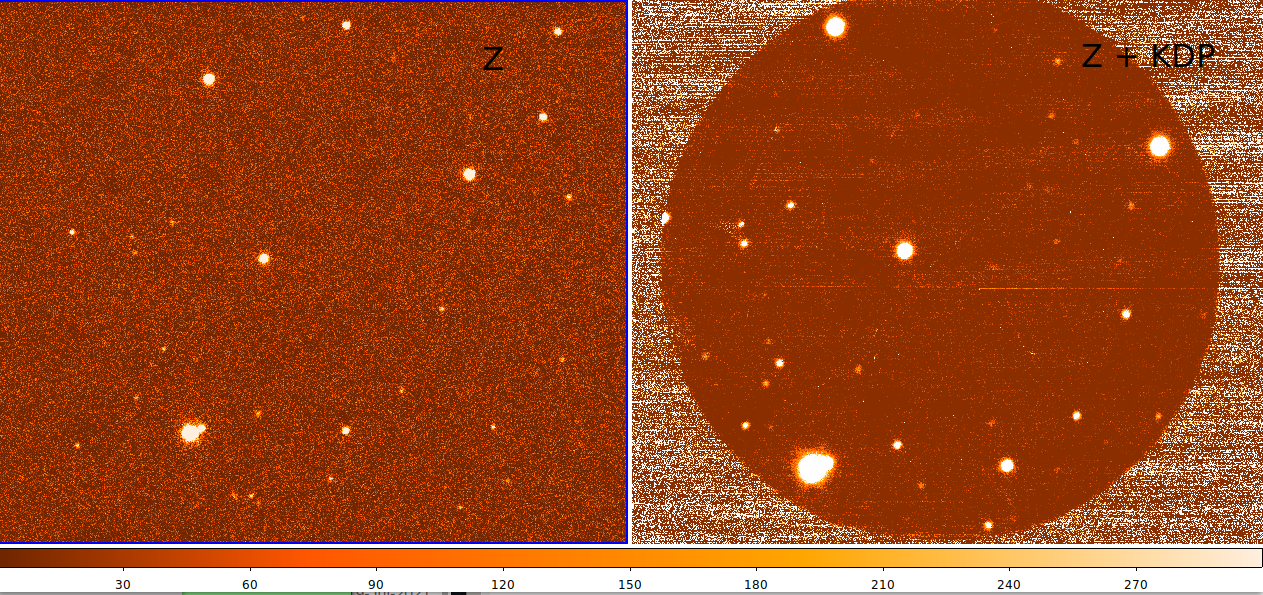
Conclusions
- Verified that the pieces had been swapped, KDP is the one with a scratch mark.
- Confirmed that structure has appeared when the central wheel unit is at about -90 deg.
- It did not help to shield the crystal by having it on the other side of the aperture
wheel, i.e. away from the beam.
- The structure looks different at every cool-down.
- Transmission varies across the crystal and is lower than the expected 90% even at its
maximum.
- The KDP blocks well the K-band, while the DKDP blocks it less well.
Comments to Amanda









